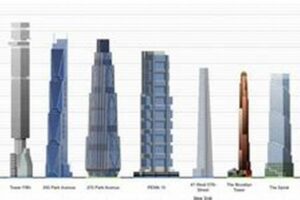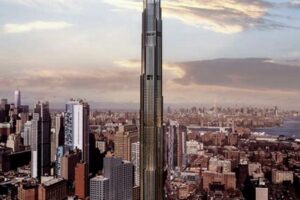Old New York City skyscrapers are a testament to the city’s rich history and architectural prowess. These towering structures, many of which were built in the early 20th century, have shaped the city’s skyline and continue to be admired by visitors and residents alike.
The Empire State Building, Chrysler Building, and Bank of Manhattan Trust Building are just a few examples of the many iconic old skyscrapers that can be found in New York City. These buildings are not only architectural marvels but also important landmarks that have played a role in the city’s history and culture.
In this article, we will take a closer look at some of the most famous old skyscrapers in New York City, exploring their history, architecture, and cultural significance. We will also discuss the importance of preserving these buildings and the role they continue to play in the city’s identity.
1. Architectural Marvels
Old NYC skyscrapers are architectural marvels that pushed the boundaries of construction at the time they were built. These buildings showcased innovative design and engineering techniques, and many of them continue to stand as testaments to the ingenuity of their creators. For example, the Empire State Building was the tallest building in the world when it was completed in 1931, and it remained the tallest building for over 40 years. The Chrysler Building, completed in 1930, was the first building to have a spire that was taller than its roof, and it remained the tallest building in the world until the Empire State Building was completed.
The innovative design and engineering techniques used in old NYC skyscrapers have had a lasting impact on the way that skyscrapers are built today. For example, the steel frame construction method, which was pioneered in the construction of the Flatiron Building in 1902, is still used in the construction of skyscrapers today. The setback design, which was first used in the construction of the Zoning Law Building in 1916, is also still used in the construction of skyscrapers today, as it helps to reduce wind resistance and improve energy efficiency.
The architectural marvels of old NYC skyscrapers continue to inspire architects and engineers around the world. These buildings are a reminder of the ingenuity and creativity of the people who built them, and they continue to shape the way that we think about architecture and engineering today.
2. Historical Landmarks
Old NYC skyscrapers are not only architectural wonders but also important landmarks that have played a role in the city’s history and culture. These buildings have witnessed and been a part of some of the most important events in the city’s history. For example, the Empire State Building was the site of the famous “King Kong” climb in 1933, and the Chrysler Building was the tallest building in the world for 11 months in 1930. These buildings have also been used as symbols of the city’s resilience, such as when the Empire State Building was used as a communications tower after the 9/11 attacks.
In addition to their historical significance, old NYC skyscrapers are also important cultural landmarks. These buildings have been featured in countless works of art, literature, and film. For example, the Empire State Building has been featured in films such as “King Kong” (1933), “Sleepless in Seattle” (1993), and “Elf” (2003). These buildings have also been used as symbols of the city’s cultural diversity, such as when the Chrysler Building was used as the backdrop for a Diwali celebration in 2016.
The historical and cultural significance of old NYC skyscrapers makes them important landmarks that should be preserved and celebrated. These buildings are a reminder of the city’s rich history and culture, and they continue to play a role in the city’s identity today.
3. Cultural Icons
Old NYC skyscrapers have become cultural icons, deeply ingrained in the identity of New York City. Their distinctive silhouettes and architectural grandeur have made them instantly recognizable symbols of the city, both domestically and internationally. This cultural significance is evident in their frequent representation in various forms of artistic expression.
- Architectural Masterpieces:
Old NYC skyscrapers are celebrated for their architectural brilliance and engineering prowess. Their innovative designs and soaring heights have captivated the imagination of artists, who portray them as symbols of human ambition and achievement.
- Backdrops for Stories:
The iconic status of old NYC skyscrapers has made them popular settings for works of fiction. Their presence in books, films, and television shows adds depth and authenticity to stories set in the city.
- Artistic Inspirations:
The visual impact of old NYC skyscrapers has inspired countless works of art. Their unique forms and textures have been captured in paintings, sculptures, and photographs, showcasing their beauty and architectural significance.
- Cultural Heritage:
Old NYC skyscrapers are not only architectural marvels but also cultural heritage sites. They embody the city’s history, growth, and aspirations. Their preservation and restoration efforts reflect the importance placed on their cultural significance.
The cultural significance of old NYC skyscrapers extends beyond their physical presence. They have become symbols of the city’s identity, creativity, and resilience. Their enduring appeal continues to inspire and captivate people worldwide.
4. Tourist Attractions
Old NYC skyscrapers are major tourist attractions, drawing visitors from around the globe to admire their architectural splendor and historical significance. These iconic structures offer a unique blend of architectural marvels and historical narratives that captivate tourists and provide valuable insights into the city’s rich past.
- Architectural Wonders:
Old NYC skyscrapers showcase groundbreaking architectural designs and engineering feats that leave visitors in awe. Their towering heights, intricate facades, and innovative construction techniques make them architectural masterpieces that attract architecture enthusiasts and tourists alike.
- Historical Landmarks:
These skyscrapers are not just architectural wonders but also historical landmarks that have witnessed and played a role in the city’s evolution. Visitors can immerse themselves in the city’s history by exploring these buildings, learning about their construction, and understanding their impact on New York City’s growth and development.
- Cultural Icons:
Old NYC skyscrapers have become cultural icons, deeply ingrained in the city’s identity and popular culture. They have been featured in countless works of art, literature, and film, making them recognizable symbols of New York City and attracting tourists eager to experience these iconic landmarks.
- Observatory Decks:
Many old NYC skyscrapers offer observatory decks that provide breathtaking panoramic views of the city. Visitors can ascend to these decks to witness the city’s vastness, iconic landmarks, and vibrant energy, creating unforgettable experiences for tourists.
In conclusion, the tourist appeal of old NYC skyscrapers lies in their architectural brilliance, historical significance, cultural relevance, and the unique experiences they offer. These buildings stand as testaments to the city’s architectural heritage and continue to captivate visitors from around the world, making them essential destinations for anyone seeking to explore New York City’s rich tapestry.
5. Economic Drivers
Old NYC skyscrapers play a significant role as economic drivers, contributing to the city’s financial prosperity. These towering structures house numerous businesses, ranging from small startups to large corporations, providing employment opportunities and fueling the local economy. The presence of these businesses within skyscrapers generates revenue through rent, utilities, and other services, contributing to the city’s tax base and overall economic growth.
The iconic status of old NYC skyscrapers makes them highly sought-after locations for businesses seeking to establish a prestigious presence in the city. The architectural grandeur and historical significance of these buildings add value and enhance the image of companies that occupy them. Furthermore, the skyscrapers’ convenient locations in the heart of Manhattan provide easy access to transportation, amenities, and potential customers, making them ideal for businesses of all types.
The economic impact of old NYC skyscrapers extends beyond their direct contribution to the city’s revenue. They serve as landmarks and tourist attractions, drawing visitors from around the world. This influx of tourism generates additional revenue for businesses in the surrounding areas, such as restaurants, shops, and hotels. Moreover, the skyscrapers’ architectural and historical significance attracts investment and development in the surrounding neighborhoods, stimulating economic growth and revitalization.
In conclusion, old NYC skyscrapers are not merely architectural wonders but also significant economic drivers for the city. Their role in housing businesses, generating revenue, and attracting tourism contributes to the city’s financial prosperity and overall economic vitality. Understanding the connection between old NYC skyscrapers and their economic impact is crucial for policymakers, urban planners, and business leaders seeking to foster economic growth and maintain the city’s competitive edge.
6. Preservation
Old NYC skyscrapers are not only architectural marvels and economic drivers but also significant contributors to the city’s cultural heritage and identity. Preserving these buildings is crucial for maintaining this rich legacy and ensuring that future generations can continue to appreciate and learn from these iconic structures.
- Historical Landmarks:
Old NYC skyscrapers are historical landmarks that tell the story of the city’s growth and development. They represent different architectural styles and engineering feats that have shaped the city’s skyline over time. Preserving these buildings allows us to connect with the past and appreciate the contributions of previous generations.
- Architectural Heritage:
These skyscrapers showcase innovative architectural designs and techniques that have influenced modern architecture. Preserving them ensures that we continue to learn from and draw inspiration from these architectural masterpieces.
- Cultural Icons:
Old NYC skyscrapers have become cultural icons that symbolize the city’s identity and spirit. They have been featured in countless works of art, literature, and film, and have captured the imagination of people worldwide. Preserving these buildings safeguards this cultural legacy and ensures that future generations can continue to experience these iconic landmarks.
- Sense of Place:
Old NYC skyscrapers contribute to the city’s unique sense of place. They define the city’s skyline and create a sense of continuity and belonging among its residents. Preserving these buildings helps maintain the city’s character and fosters a sense of community pride.
Preserving old NYC skyscrapers requires careful planning, restoration, and maintenance. It involves balancing the need for modernization with the preservation of their historical and architectural integrity. By investing in the preservation of these iconic buildings, we invest in the city’s future and ensure that its rich architectural heritage and cultural identity continue to thrive.
7. Inspiration
Old NYC skyscrapers stand as testaments to the enduring power of design and innovation. Their unique architectural styles, innovative engineering techniques, and sheer grandeur continue to captivate architects and engineers worldwide, inspiring new design solutions and pushing the boundaries of modern architecture.
- Architectural Masterpieces:
Old NYC skyscrapers are architectural marvels that showcase the ingenuity and creativity of their designers. Their iconic forms, intricate details, and innovative use of materials have served as inspiration for generations of architects, who continue to draw upon these timeless designs for inspiration and guidance.
- Engineering Innovations:
The construction of old NYC skyscrapers involved groundbreaking engineering techniques that have shaped modern construction practices. From the development of steel-frame construction to the use of elevators and mechanical systems, these skyscrapers pushed the boundaries of engineering and continue to inspire engineers today.
- Vertical Living:
Old NYC skyscrapers played a pivotal role in the development of vertical living and urban density. Their ability to accommodate large numbers of people within a limited footprint has influenced modern urban planning and architecture, inspiring the design of sustainable and space-efficient buildings.
- Cultural Impact:
Old NYC skyscrapers have transcended their architectural significance to become cultural icons. Their presence in popular culture, art, and literature has fostered a deep appreciation for their design and inspired architects to create buildings that resonate with the public imagination.
In conclusion, old NYC skyscrapers continue to inspire architects and engineers around the world due to their enduring architectural value, innovative engineering techniques, impact on vertical living, and cultural significance. These timeless structures serve as a source of inspiration and guidance, shaping the future of architecture and engineering.
FAQs on Old NYC Skyscrapers
This section addresses frequently asked questions and misconceptions surrounding old NYC skyscrapers, providing informative answers based on historical facts and architectural significance.
Question 1: Why are old NYC skyscrapers so tall?
The height of old NYC skyscrapers was driven by several factors. The desire for prestige and prominence motivated architects and developers to create taller buildings that would stand out in the competitive urban landscape. Additionally, the increasing land prices in Manhattan made it more economical to build upwards rather than outwards.
Question 2: How were old NYC skyscrapers built without modern construction equipment?
The construction of old NYC skyscrapers involved innovative engineering techniques and skilled craftsmanship. Workers used steam-powered hoisting machines, hand tools, and ingenuity to lift materials and assemble these towering structures.
Question 3: Are old NYC skyscrapers safe?
The safety of old NYC skyscrapers is a top priority. Regular inspections, maintenance, and retrofits are conducted to ensure that these buildings meet modern safety codes. Many old skyscrapers have undergone significant upgrades to their structural systems, fire safety measures, and mechanical equipment.
Question 4: Why preserve old NYC skyscrapers?
Preserving old NYC skyscrapers is crucial for several reasons. These buildings represent the city’s architectural heritage, showcasing the evolution of design and engineering techniques. They also contribute to the city’s unique identity and sense of place. Preserving these landmarks ensures that future generations can appreciate and learn from these architectural marvels.
Question 5: How can I visit old NYC skyscrapers?
Many old NYC skyscrapers offer public access through observation decks, guided tours, and special events. Visitors can experience breathtaking views of the city, learn about the buildings’ history and architecture, and appreciate the craftsmanship that went into their construction.
Question 6: What are some of the most famous old NYC skyscrapers?
Some of the most iconic old NYC skyscrapers include the Empire State Building, Chrysler Building, Woolworth Building, Bank of Manhattan Trust Building, and American Radiator Building. These landmarks have become symbols of the city’s architectural prowess and cultural significance.
Understanding these aspects of old NYC skyscrapers enhances our appreciation for their architectural value, historical importance, and ongoing relevance in shaping the city’s identity.
Proceed to the next section to explore the architectural styles that have influenced the design of old NYC skyscrapers.
Tips for Preserving Old NYC Skyscrapers
Preserving old NYC skyscrapers requires a multifaceted approach that involves careful planning, restoration, and maintenance. Here are a few key tips to ensure the longevity and integrity of these architectural icons:
Tip 1: Regular Inspections and Maintenance
Conduct regular inspections to identify any potential issues or areas requiring attention. Address maintenance needs promptly to prevent minor issues from escalating into larger problems.
Tip 2: Sensitive Restoration Techniques
When undertaking restoration projects, use sensitive techniques that preserve the historical character of the building. Avoid drastic alterations or the use of materials that are not compatible with the original design.
Tip 3: Adaptive Reuse
Consider adaptive reuse strategies to give new life to old skyscrapers while preserving their architectural integrity. This involves repurposing the building for a new use, such as converting an office building into a residential or mixed-use space.
Tip 4: Code Compliance and Retrofitting
Ensure that old skyscrapers meet current building codes and safety standards. Conduct necessary retrofits to improve structural integrity, fire safety, and accessibility while respecting the historical fabric of the building.
Tip 5: Community Involvement
Engage the local community in preservation efforts. Encourage public awareness and support for the preservation of these landmarks, as they contribute to the city’s cultural heritage and sense of place.
Tip 6: Financial Incentives
Explore financial incentives and tax credits available to support the preservation and rehabilitation of old skyscrapers. These incentives can help offset the costs associated with these projects.
Tip 7: Collaboration and Partnerships
Foster collaboration between building owners, architects, engineers, historians, and preservationists. A multidisciplinary approach ensures that preservation efforts are informed by expertise and diverse perspectives.
Tip 8: Long-Term Planning
Develop a comprehensive long-term plan for the preservation and maintenance of old skyscrapers. This plan should outline strategies for ongoing care, adaptive reuse, and financial sustainability.
By following these tips, we can ensure that old NYC skyscrapers continue to grace the city’s skyline for generations to come. These iconic structures are not only architectural marvels but also repositories of our history and cultural identity. Preserving them is an investment in the future and a tribute to the ingenuity of the past.
Conclusion
In conclusion, old NYC skyscrapers stand as enduring testaments to architectural innovation, historical significance, and cultural identity. Their towering heights, intricate designs, and innovative engineering techniques continue to inspire architects and engineers worldwide.
Preserving these iconic structures is not merely a matter of protecting buildings; it is about safeguarding the city’s architectural heritage, fostering a sense of place, and ensuring that future generations can appreciate the enduring power of design. By embracing sensitive restoration practices, adaptive reuse strategies, and community involvement, we can ensure that old NYC skyscrapers continue to grace the city’s skyline and enrich the lives of all who experience them.
These architectural marvels are more than just steel and glass structures; they are symbols of human ingenuity, cultural achievement, and the indomitable spirit of New York City.







